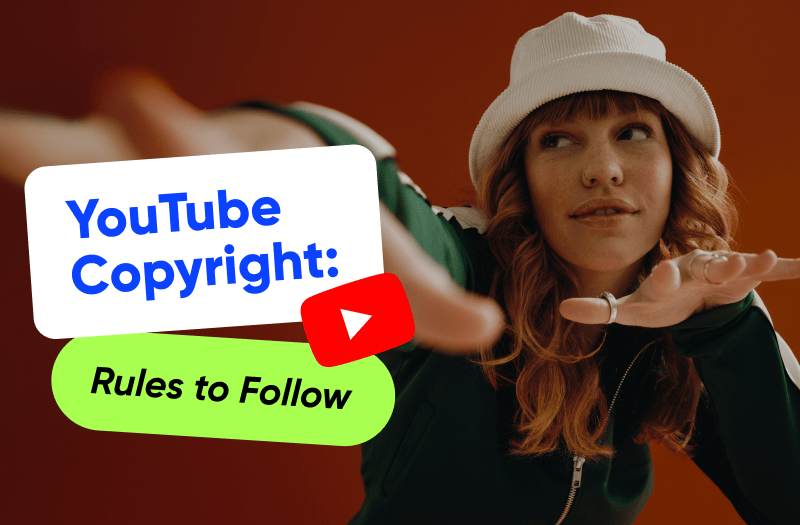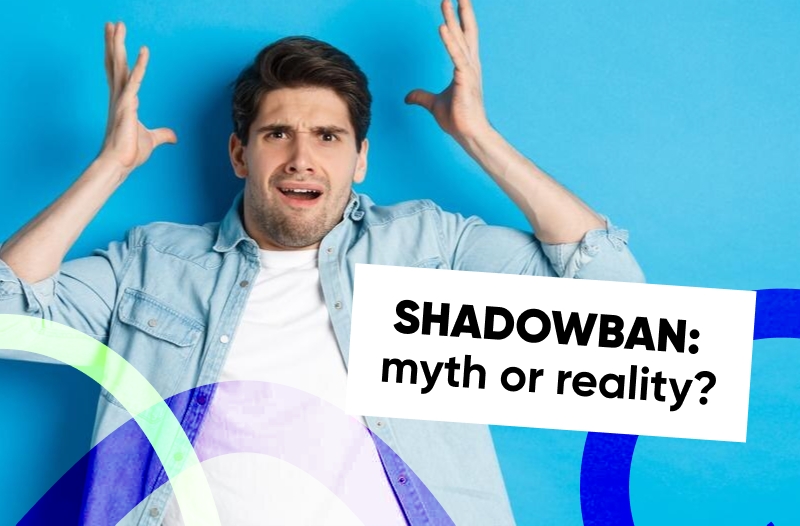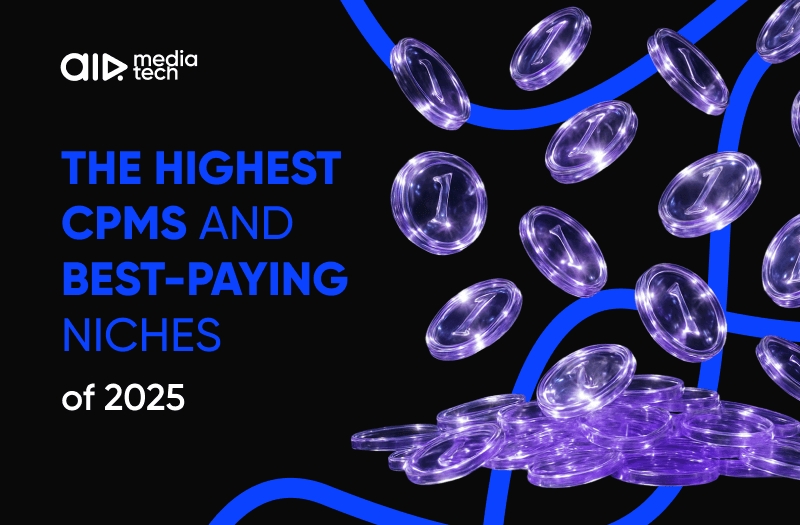
Trying to resolve copyright claims and puzzled about how many copyright strikes on YouTube can impact your channel, or what is considered copyright on YouTube? You're in good company.
Many creators share these concerns. In this guide, we'll simplify YouTube's copyright rules, helping you navigate the waters with confidence. Let's dive in and clear the air!
What is copyright on YouTube: rules of copyright
YouTube copyright laws are a form of protection for intellectual property, distinct from trademarks which protect brand names, slogans, logos, and other symbols. Within the YouTube community, every video is an audiovisual work. The creator of this video is the copyright holder and has exclusive rights to post it on their channel and grant permissions for its use.
Types of Copyrighted Content:
- Audiovisual works
- Sound recordings and music compositions
- Written works like articles and books
- Artworks like paintings and posters
- Video games and computer software
- Dramatic pieces like plays
Content Not Protected by Copyright:
- Ideas
- Facts
- Processes
- Titles
Both individuals and companies can hold copyrights, and rights remain with the author's heirs for 70 years post their death.
What happens if you get a copyright claim on YouTube
If YouTube detects potential copyright violations, either through its AI system or via complaints, it can impose penalties. These systems use perceptual hash algorithms, considering titles, keywords, meta tags, and descriptions to identify violations.
Potential Consequences of copyright violations:
- Receiving a warning or strike.
- Limited channel functionalities.
- Immediate channel blockage or after accumulating 3 strikes, depending on the violation's severity.
With each strike, the channel's reputation and its features can be limited, such as losing live streaming abilities after the first strike. If you need help with preventing or resolving strikes on YouTube, contact us! As a YouTube Certified Partner, we'll handle it quickly.
Can I use other YouTube videos in my video
Even if you give credit to the copyright holder, use unmonetized videos, or have bought content from online stores, you are still at risk of copyright violations if you use someone else's video without permission. It's crucial to remember that being inspired by someone's content is different from directly using or copying it. Nevertheless, there are ways to utilize content without infringing on copyrights. Let's dive right into exploring these options.
How to legally use copyrighted video on YouTube
The primary method for legally using someone else's content is to obtain permission from the copyright holder. Reach out to the original creator and ask for written permission. This can be done through YouTube's messaging system, email, or other social media platforms.
You can also use content that falls under "fair use". This is a legal concept that, in certain instances, permits the reuse of copyrighted material without requiring special permission from the copyright holder. "Fair use" varies by country. In the U.S., for instance, a judge evaluates fair use based on four criteria:
- How and what the materials are used for, such as educational purposes or to generate income. Usually, the courts check whether the work is derivative, whether the original design and content have been changed, or whether the user copied the content. Most likely, commercial use will not be considered fair, although there are ways to make a profit from such a video without infringing anyone’s rights.
- What is the essence of copyrighted work? If the source material is based on well-known facts and is not fiction, its use in a derivative work may well be considered fair.
- The size and significance of the fragment used in relation to the entire copyrighted work. If only a tiny portion is copied, such use will be considered fair use rather than if you have copied a significant part of the original work. However, if the passage contains the main idea of the original work, then the court can take the side of the copyright holder.
- The resulting effect that using protected materials has on the potential market or income of the copyright holder. The original work is usually not considered in good faith if the copyright holder has lost profits as a result.
Another option is to use content that is labeled as Creative Commons or Public Domain:
- Creative Commons licenses provide a standardized way for content creators to allow others to use their work.
- Public Domain indicates that content has lost its copyright protection over time and is free for anyone to use.
AIR Media-Tech has helped thousands of content creators resolve strikes and prevent channel blockage. Reach out to us for professional support!
Avoid copyright infringement on YouTube
Here are some valuable tips to help you protect the content being used and avoid bans and strikes for using someone’s intellectual property:
- Beware of Music and Audio: One of the most common copyright infringements on YouTube is due to the unauthorized use of music. Always make sure you have the rights to any music or sound effects you use. Use music exclusively from your production or the YouTube audio library;
- Keep Watermarks: When using images from the web that have copyright or watermark marks, never erase them;
- Add Value: Ensure that you're adding unique value to the content you borrow. Simply reposting someone else's content without significant modification or commentary will likely violate copyright rules.
- Respond Promptly to Copyright Notices: If you receive a copyright notice from YouTube, address it promptly. Whether it's correcting the issue, disputing the claim, or seeking further clarity, it's essential to act quickly.
- Give Credit: Even if a video is available for reuse, always credit the original creator in your video and description. This is not only respectful but can also help clarify the source of the content.
- Educate Yourself with YouTube’s Copyright School: If you receive a copyright strike, YouTube will require you to go through their “Copyright School”. It’s beneficial to review this content even if you haven’t received a strike to better understand the platform’s expectations
- Avoid Monetizing: If you’re using someone else’s content, even under the umbrella of fair use, consider not monetizing that specific video to minimize potential conflicts.
How to dispute copyright strikes on YouTube
If you receive a copyright infringement warning, you will have to wait 3 months before it disappears. If you are sure you are without fault, then be ready to file an appeal. Do not spam the administration with letters - fill out the form once and wait for a response. If you are refused, you can re-apply only after 60 days.
If the warning is related to copyright, then there are four options:
- Strike disappears by itself after 90 days, but only if you take a course on Youtube copyright;
- Contact the user (the person who submitted the strike is always indicated) and ask them to withdraw the complaint;
- Are you the content author yourself? Submit a counter-notification. But only if you can prove your authorship.
- Get in touch with YouTube Certified Partner to solve the problem faster.
On the other hand, if you're a creator looking to safeguard your copyright and potentially earn revenue from it, YouTube offers a suite of tools just for you:
- DMCA-compliant online form: Accessible to all of YouTube's visitors, ensuring compliance with copyright requirements and offering a channel for rights protection.
- Copyright Match Tool: It notifies users when videos are uploaded by others that might include their copyrighted works.
- Content ID system: This system has also become a revenue source for creators, with YouTube having paid out billions in ad revenue to rights holders who monetized their content using Content ID.
Now you know all about how YouTube copyright works and how to use content on YouTube without copyright infringement. Do not forget that all copyright materials fall under the Digital Millennium Copyright Act (DMCA) and are protected by the law.
Create, inform, entertain, monetize, and promote video content without getting into disputes with copyright holders! Keep in mind that AIR Media-Tech is always here to help you solve any issue with your YouTube channel.






